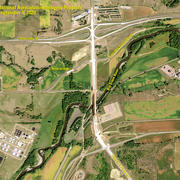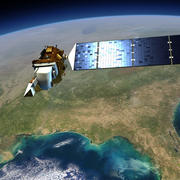Earth Resources Observation and Science (EROS) Center
Home
At the USGS EROS Center, we study land change and produce land change data products used by researchers, resource managers, and policy makers across the nation and around the world. We also operate the Landsat satellite program with NASA, and maintain the largest civilian collection of images of the Earth’s land surface in existence, including tens of millions of satellite images.
What's New at EROS?
Eyes on Earth is a podcast covering a range of topics on remote sensing, satellite operations, and the science of Earth observation. Watch for new episodes every two weeks.
Listen hereImage of the Week
The western wall of Uzbekistan's Sardoba Reservoir breached on May 1st, 2020 after a week of heavy rain. Imagery from Landsat and Europe's Copernicus Sentinel-2 satellites tell the story of the impact.
Uzbekistan DamNews
High Resolution Imagery Captures Growth in South Dakota’s Largest City
The high-tech hub that is the USGS Earth Resources Observation and Science (EROS) Center was carved out of a chunk of rural farm ground nearly 50 years ago, and the Center still counts more cows and cornstalks than human beings as neighbors.
Landsat 9 Launch Delay Raises Questions about Science Data Acquisitions
The slipping of Landsat 9’s original launch readiness date from December 2020 to September 2021 brings with it uncertainty to the Landsat user community, but no real panic at this point.
USGS Supports the 2020 National Space Policy
In support of the President’s policy, USGS and NASA will leverage their full technological abilities to meet the nation’s growing environmental information needs.
Publications
Investigation of land surface phenology detections in shrublands using multiple scale satellite data
Shrublands occupy about 13% of the global land surface, contain about one-third of the biodiversity, store about half of the global terrestrial carbon, and provide many ecosystem services to a large amount of world's human population and livestock. Because phenology is a sensitive indicator of the response of shrubland ecosystems to climate change...
Peng, Dailiang; Wang, Yan; Xian, George Z.; Huete, Alfredo R; Huang, Wenjiang; Shen, Miaogen; Wang, Fumin; Yu, Le; Liu, Liangyun; Xie, Qiaoyun; Liu, Lingling; Zhang, XiaoyangThe new Landsat Collection-2 Digital Elevation Model
The Landsat Collection-2 distribution introduces a new global Digital Elevation Model (DEM) for scene orthorectification. The new global DEM is a composite of the latest and most accurate freely available DEM sources and will include reprocessed Shuttle Radar Topographic Mission (SRTM) data (called NASADEM), high-resolution stereo optical data (...
Franks, Shannon; Storey, James C.; Rengarajan, RajagopalanLandscape and climatic influences on actual evapotranspiration and available water using the Operational Simplified Surface Energy Balance (SSEBop) Model in eastern Bernalillo County, New Mexico, 2015
The U.S. Geological Survey, in cooperation with the Bernalillo County Public Works Division, conducted a 1-year study in 2015 to assess the spatial and temporal distribution of evapotranspiration (ET) and available water within the East Mountain area in Bernalillo County, New Mexico. ET and available water vary spatiotemporally because of complex...
Douglas-Mankin, Kyle R.; McCutcheon, Ryan J.; Mitchell, Aurelia C.; Senay, Gabriel B.







